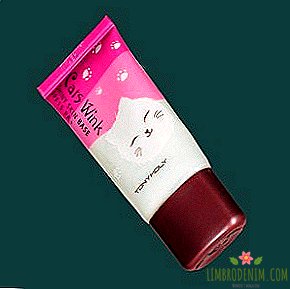Carcinogens: What substances cause cancer - and should they be avoided
According to the WHO, cancer (in particular, cancer of the lung, trachea and bronchi) rank fifth in the list of leading causes of death in the world. At the same time, they are much more afraid of them than coronary heart disease or stroke, who are in the first two positions. Fear gave rise to panic: carcinogens are now looking for - and are finding - in everything, from cigarette smoke and exhaust gases to non-stick frying pans and coffee. We figure out which of them can really hide from and whether to do it.

What it is
The name speaks for itself: carcinogen is a substance or effect that affects the integrity of DNA and contributes to carcinogenesis, that is, the formation and reproduction of malignant cells. The fact that there are chemicals with such effects, it became known about a hundred years ago, and in 1916, Japanese scientists were able to cause cancer in a rabbit for the first time during the experiment: the animal was coated with coal tar every day. Of course, the ethics of research was not discussed then - but in medicine there was a revolution, because for the first time it was possible to see how a malignant tumor occurs in an absolutely healthy individual under the influence of chemicals.
Since the resin was a complex mixture of chemicals, scientists (not only in Japan) went in search of other substances that could cause cancer. Despite the fact that carcinogens are actually more often found in synthetic substances, studies have shown that plant compounds may also have carcinogenic properties. However, this does not make either of them certainly unsafe.
What are the carcinogens
Scientists have not fully decided how best to classify the effects that can cause cancer: they are divided into radioactive (this group includes all types of hazardous radiation) and non-radioactive, then genetic and associated with environmental exposure. The latter include lifestyle factors - smoking, alcoholism, unhealthy diet, low levels of physical activity, and exposure to sunlight or viruses, working in hazardous industries, and using certain drugs like chemotherapy drugs. By and large, it does not matter how to classify carcinogens - it is important what it can give in practice. After all, if a certain therapy, even carrying the risk of carcinogenesis, is sometimes impossible to refuse, then the influence of other factors can be minimized (for example, by protecting the skin from the sun or quitting smoking).
Carcinogens affect DNA, causing dangerous changes - but the latter do not necessarily lead to the formation of a tumor, they only increase the likelihood that the reproduction of abnormal cells will reach a level at which the immune system will not cope. A recent study found that two thirds of the genetic mutations that lead to cancer are errors that occur spontaneously when copying DNA, and only the remaining third arises due to environmental carcinogens.
Are they so scary?
The list of carcinogens compiled by WHO is constantly updated; for a layman who sees a document for the first time, it can cause horror - it seems that all the products and substances mentioned in it are terribly dangerous. In fact, this is not the case - and all carcinogens in the list are assigned a special code: 1 (human carcinogen), 2a and 2b (potentially human carcinogen, and for "a" the probability is higher than for "b"), 3 (not classified as carcinogenic to humans), 4 (perhaps not carcinogenic to humans).
Not so many agents fall into the first, most dangerous group - scientists are still not sure about the carcinogenicity of chlorinated water, caffeine even in large quantities, hair dyes, dental materials, sulfites, which are often used in cosmetics, or tea (all these substances are labeled with code 3), as well as categorized into categories 2a and 2b of red meat, aloe vera leaf extract, or shift work that disrupts circadian rhythms. This is a random sample of familiar products from the "carcinogenic list", which shows why you shouldn’t believe the screaming headlines about "new research, the results of which shock you."
Many substances included in the list of carcinogens are not as dangerous as they seem: we are not under their influence sufficiently or do not consume them in the quantities necessary for causing real harm. Attempts to eliminate from the life of absolutely all carcinogen-like substances can affect mental health, awarding you with anxiety or ortorexia. But still it is worth paying attention to those carcinogens that are recognized as truly dangerous and at the same time amenable to control.

Should we be afraid of fried food
Research has increasingly hinted that burnt food should be feared. According to scientists, the blame for all acrylamide is a compound that is formed during the heat treatment of some products, especially rich in carbohydrates. This substance is also used in the textile, plastics and paper industries, in the synthesis of dyes and in wastewater treatment. However, there is still no convincing evidence of its harm to humans, although there is evidence of the ability of acrylamide to interact with DNA and lead to certain mutations - and its place in the list with code 2a is explained by studies in which mice and rats were dosed in tens Thousands more than what you can get.
In general, the carcinogenicity of fried potatoes for humans is not proven. Experts believe that the consumption of fried carbohydrates really should be reduced for the reason that they are full of unnecessary calories - and obesity is one of the main triggers of malignant tumors throughout the world.
Will the transition to electronic cigarettes
Of course, smoking is everyone’s personal choice, but you can’t argue with statistics: it is the main cause of lung cancer. It is very important to try to protect yourself from passive smoking: according to research data, components of cigarette smoke, such as benzene, polonium-210, benzopyrene and nitrosamines, not only provoke DNA damage, but also affect the genes that encode the body's ability to defend against cancer while working thus in two directions at once. Once in the blood, chemicals from cigarette smoke spread throughout the body, which puts at risk not only the lungs, but also the kidneys, liver, digestive system, bladder, ovaries and other organs.
At the same time, vapes, which were invented precisely in order to reduce the risks associated with smoking (e-cigarette as we know it, patented in 2003, and in 2004, the Chinese Khon Lik launched to the market, whose father shortly before this died of lung cancer), it turns out to be almost worse. Their main problem is little knowledge. But even negligible in comparison with cigarettes, the number of studies suggests that a cocktail of chemicals contained in smoking fluids gradually causes irreparable harm to the body.
Alcohol is also a carcinogen.
Alcohol is considered a common cause of cancer of the breast, larynx, liver, esophagus, oral cavity, as well as the likely cause of pancreatic cancer. When alcohol enters the body, it breaks down first to acetaldehyde, and then to acetic acid. Acetaldehyde causes the liver cells to update faster than usual, and this acceleration increases the likelihood of errors when copying genes. It is important that this applies to alcohol in any drinks: aged wine, premium vodka or the cheapest beer. Although we regularly learn something new about the benefits of craft beer or red wine, the proportion of healthy skepticism does not hurt, because the risks still outweigh any benefits, and even authors justifying alcohol studies agree with this.
All of this - perhaps, along with attempts to add alcohol to a healthy lifestyle and to find a new business niche - leads to the fact that alcoholic enthusiasts are trying to bring new types of intoxicants to the market. For example, an alkosint that does not lead to the formation of acetaldehyde, or a Californian non-alcoholic wine based on marijuana - the latter can reduce the risks, because marijuana, even when smoked, is less carcinogenic than tobacco.
What about meat and sausage
In 2015, the meat was listed as a potential carcinogen. His problem, scientists believe, is in heterocyclic amines (HA) and polycyclic aromatic hydrocarbons (PAHs) - chemicals that are released during the heat treatment of meat, especially when roasting or grilling. The longer the beef is cooked, the higher the level of potential carcinogens becomes.
Let's be fair: we have not yet succeeded in finally establishing the link between HA and PAH and increasing the risk of cancer. But a number of epidemiological studies show that a passion for processed red meat increases the risk of colorectal cancer, pancreatic cancer and prostate cancer. WHO advises to consume no more than 70 grams of red and processed meat per day.
Photo:AlenKadr - stock.adobe.com, Kletr - stock.adobe.com, Vladimir Liverts - stock.adobe.com





